What is it
Text Blocks are predefined segments of text that can be repeatedly used across various templates or documents within the contractuo platform. They can contain conditional and non-conditional text and dynamic smart fields. Text blocks are the backbone of documents. They can be inserted at any point. They offer a convenient way to insert standard text, like legal clauses, terms, and conditions, or introductions, into various documents.
Who is it for
These blocks are primarily designed for content creators, including content experts and external consultants, who are responsible for generating and managing standardized text segments. They are particularly useful for those frequently dealing with repetitive text in documents.
Why use the Text Blocks
Text Blocks enhance efficiency and consistency across documents. They simplify the process of incorporating standard text into different documents, such as terms in contracts or definitions in NDAs. Central modifications to a Text Block can simultaneously update all associated documents, saving significant time and effort.
How to find the Text Blocks?
- Go to the ‘Documents‘ menu.
- Click on the ‘Core Elements‘.
- Select the ‘Text Blocks‘.
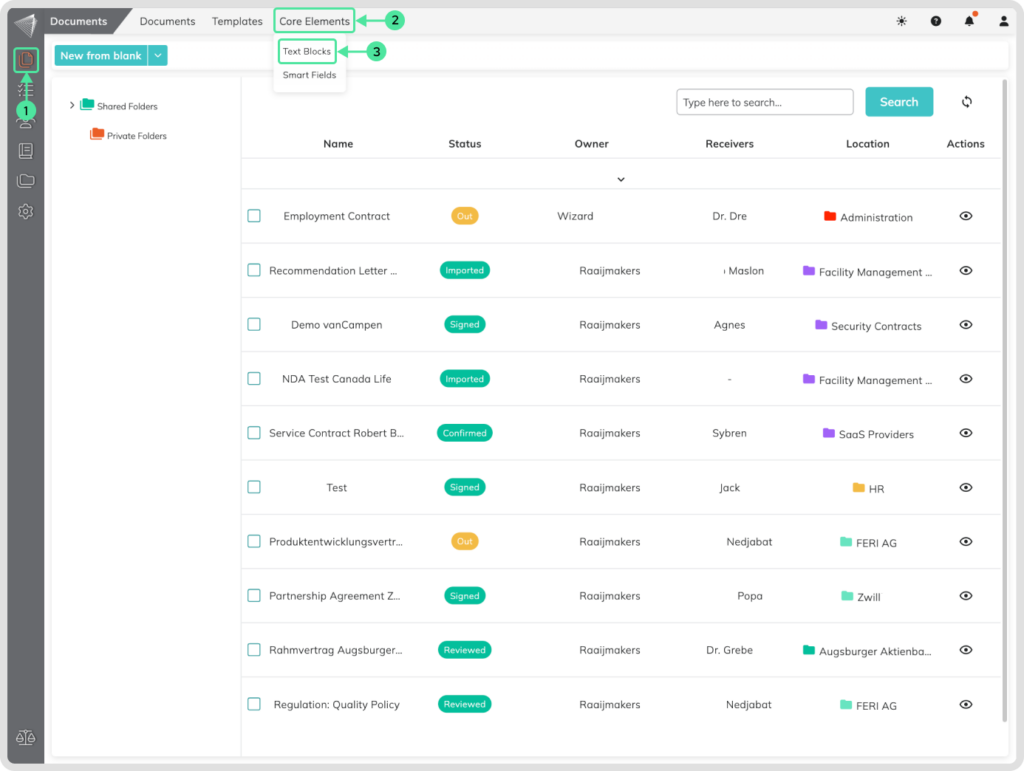
How to create a new Text Block?
Go to the Documents menu by clicking the icon on the left-side menu. Open the Core Elements, and select the Text Blocks.
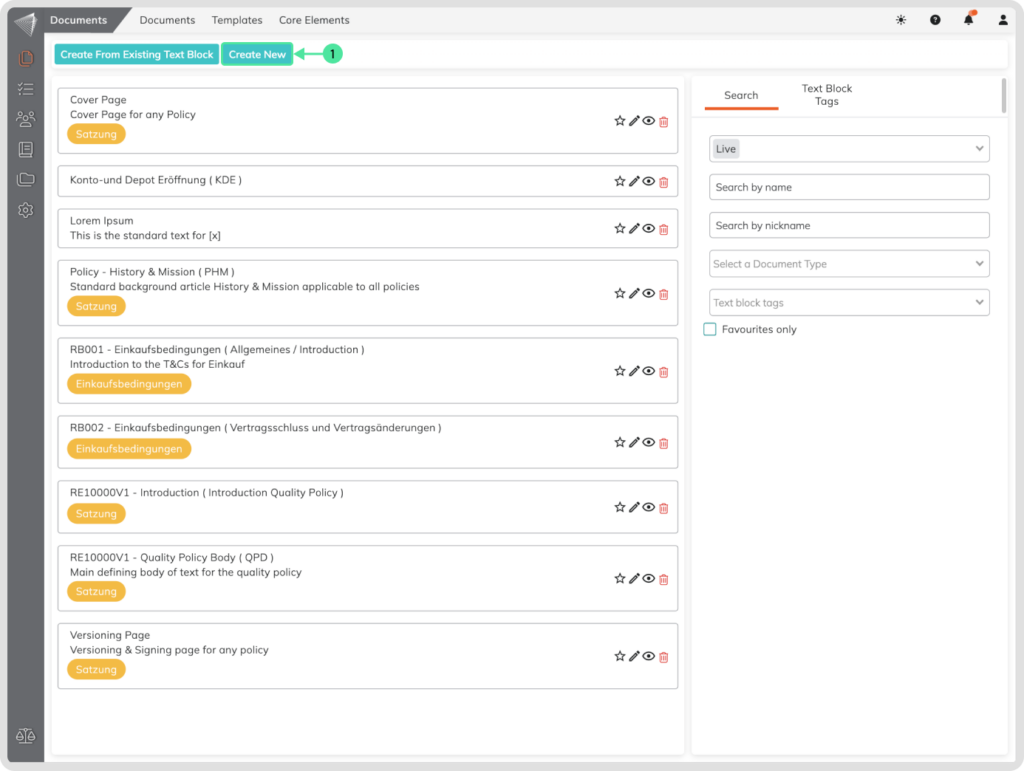
- Click on the ‘Create New’ button.
- Enter the Text block’s name.
- Enter a Text block nickname (optional).
- Enter a Text block description (optional).
- Select one or multiple Document Types to associate this Text Block with. This is a filtering option.
- Select one or multiple Text Block Tags for better categorization. This is a filtering option.
- This feature lets you set up the new text block to serve as an alternative to an existing one.
- Include a text in the editor, the default text format is Paragraph.
- From the same menu where you find the Paragraph, you can select between six Headings.
- Select from various Text Formatting options.
- You can include Smart fields inside the editor from the Toolbox Sidebar menu or by typing /dNameSmartField.
- You can include text, highlight it, and set it as a conditional text.
- It is also possible to highlight Smart Fields and set them as conditional Smart Fields.
- You can also include Tables.
- Click ‘Save’ to save it as a draft, or ‘Publish Now’ to make it immediately available. To schedule the Text Block for a future date, click on the arrow beside ‘Publish Now’ and select your desired date.
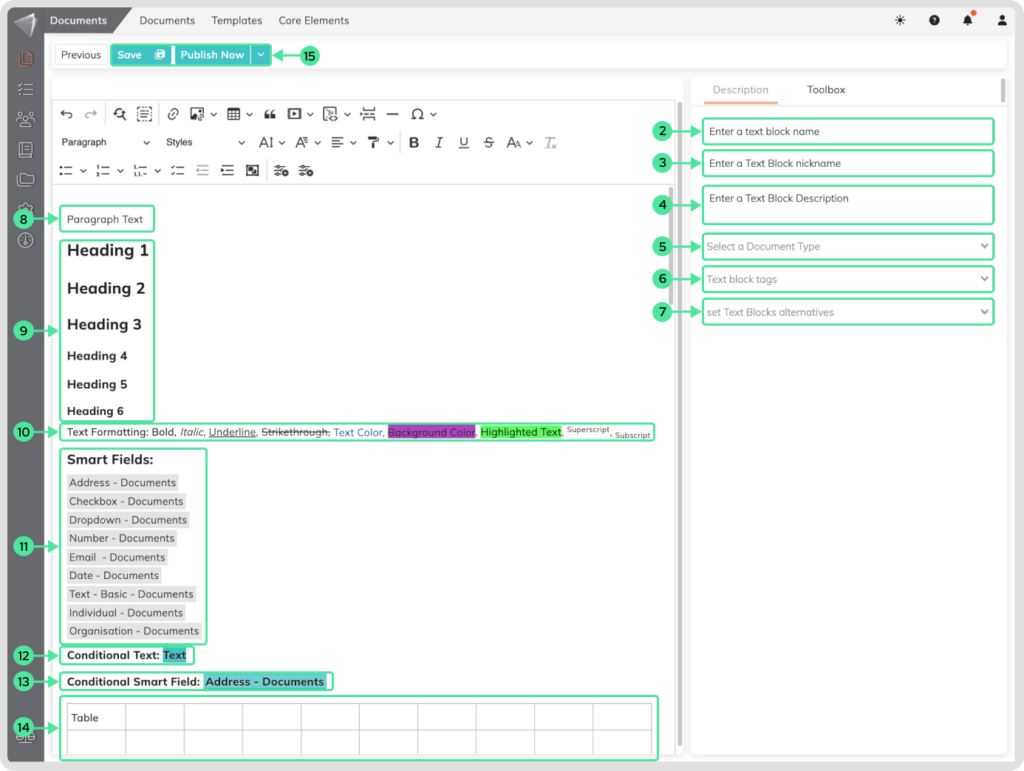
How to duplicate Text Blocks?
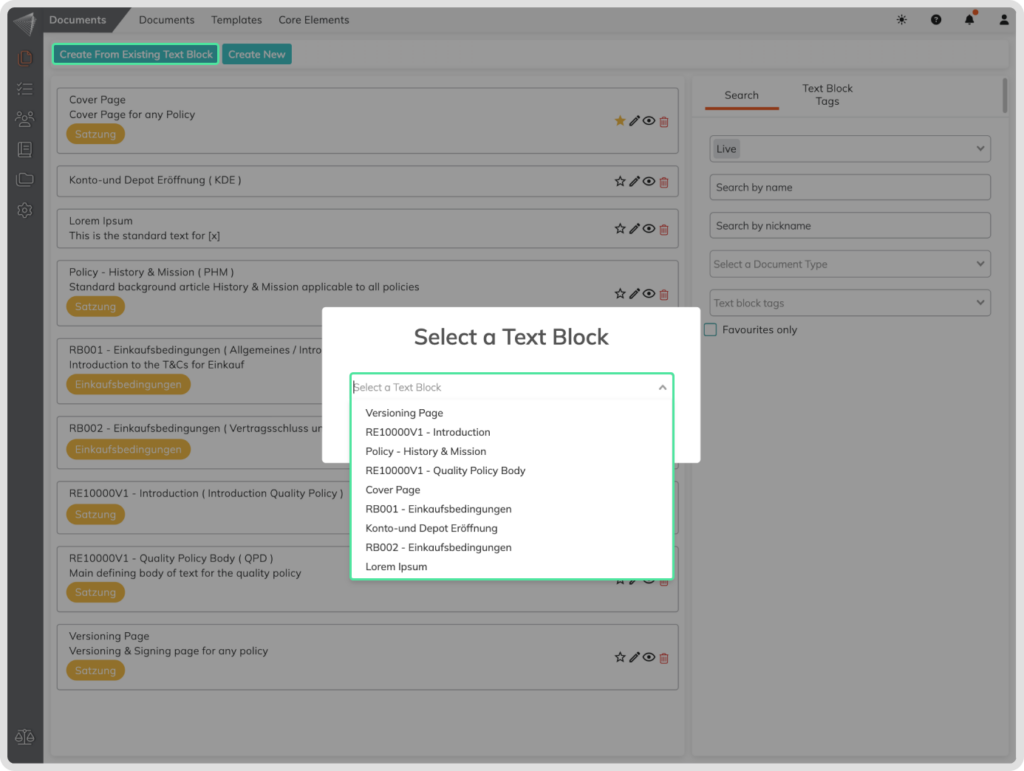
You can also duplicate text blocks. This can be achieved in two ways. Firstly, by clicking on Create existing text block. This will display a list of existing text blocks from which you want to select one to use as a base. Editing afterwards is similar to the process of creating new text blocks, except that there is already information available that can be changed. The second method is via the text block tags. To do this, click from the Manage Text Blocks menu in the Text Blocks Tags submenu and click on the Duplicate icon. A popup will appear with the list of the Tags that can be duplicate. Select the intended tag and click on the Submit button. This will duplicate all text blocks that have that tag.
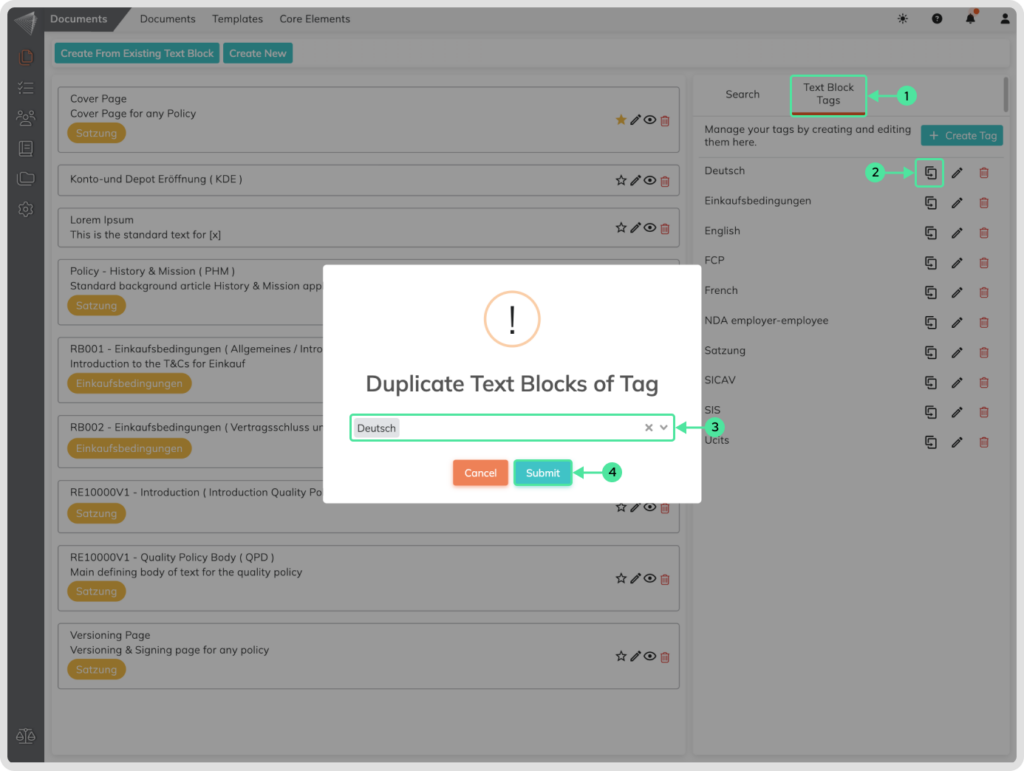
What are Text Block Tags?
Text Block Tags are labels you can attach to your text blocks to help organize and categorize them. Think of them like sticky notes or hashtags for your content. By using tags, you can easily group related text blocks, making it simpler to find, manage, and reference them in the future. Tags are a powerful way to keep your work organized and searchable, especially as you accumulate more content.
How to create a Text Block Tag?
Go to the Documents menu by clicking the icon on the left-side menu. Open the Core Elements, and select the Text Blocks.
- Select the submenu Text Blocks Tags that can be seen in the sidebar.
- Click the ‘+ Create Tag’ to create a new Tag.
- Include the new Text Block Tag Name.
- Confirm the creation.
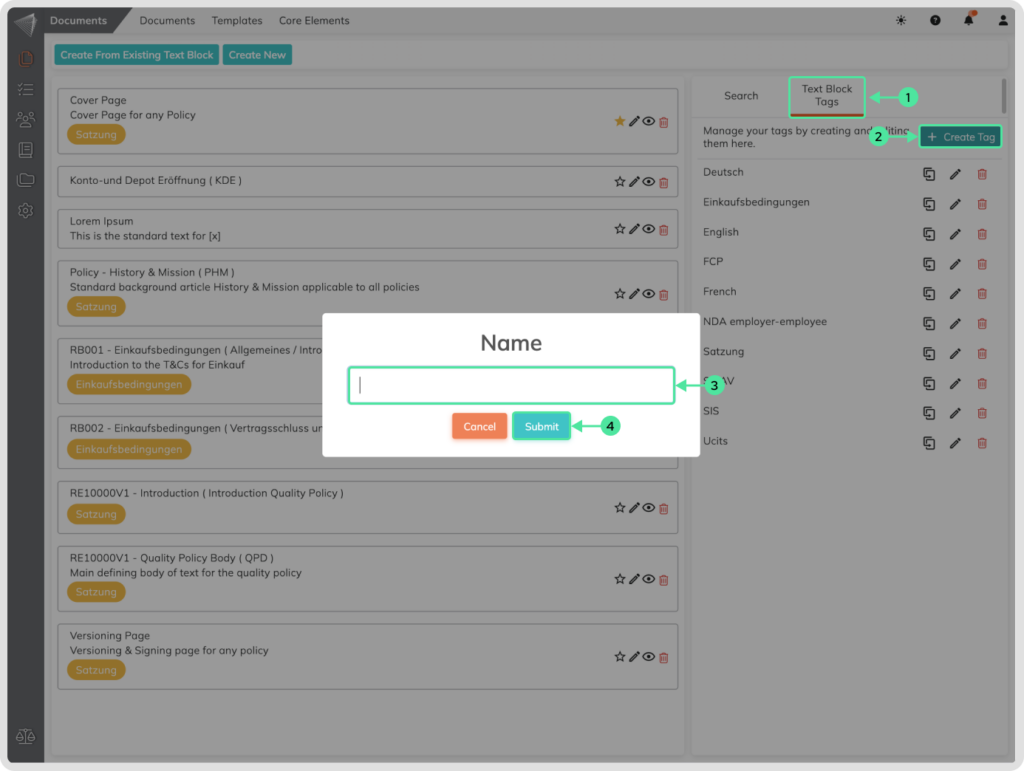
How to Add Conditions inside Text Blocks?
Go to the Documents menu by clicking the icon on the left-side menu. Open the Core Elements, and select the Text Blocks. Click the Edit Pen icon at the desired Text Block. You can also create a new Text Block and start the process from scratch.
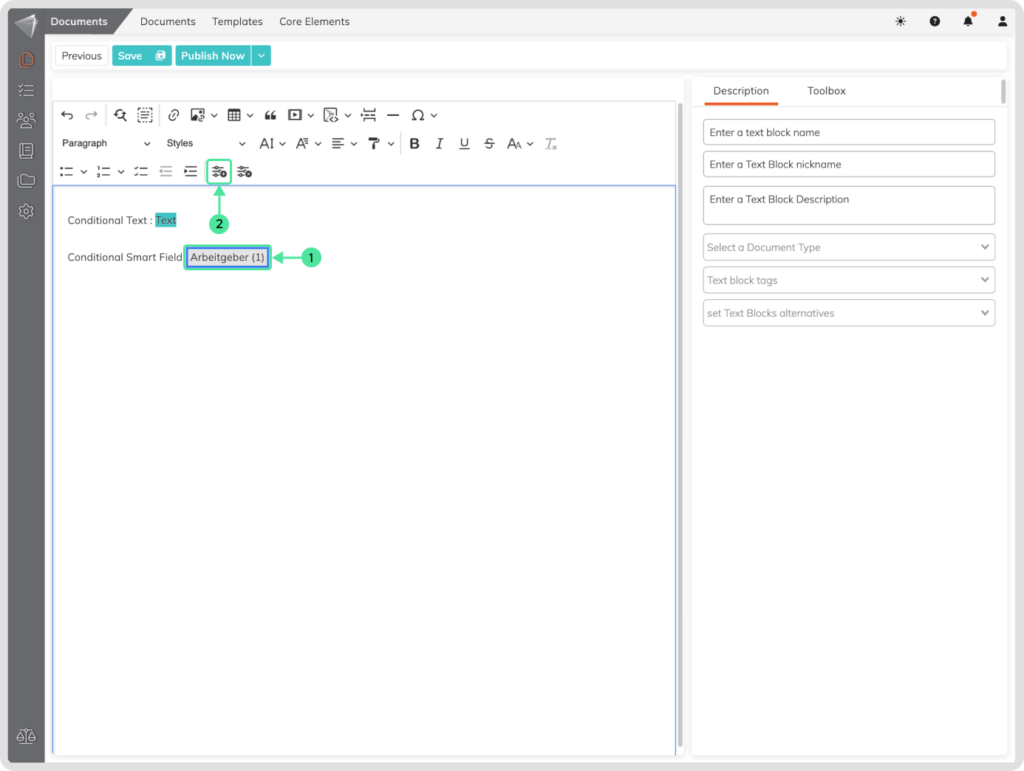
- Include your Text or dynamic Smart Fields. Smart Fields can be found in the Sidebar menu names Toolbox or type them in with the /dSmartFieldName. Highlight the desired text or smart field that should be conditional.
- Click on the ‘Attach Condition’ Button. Click on the same element to see the conditional setup process in the sidebar menu.
- Select the Form Field as the reference for your condition. (Form Fields are Smart Fields)
- Choose an operator (e.g., equals, greater than, is, etc.) to define the condition.
- Input or Select a specific triggering value, text, date, or number.
- Choose whether the text or smart field should be rendered or not based on the users input matching the condition.
- Add multiple conditions with the ‘Add a Condition’ button, if needed.
- Click on the remove condition, if you need to remove the conditional function from Text or Smart Fields.
- Save your setting by clicking on the ‘Save’ button, to save it as a draft Text block, or ‘Publish Now’ to make it directly available.
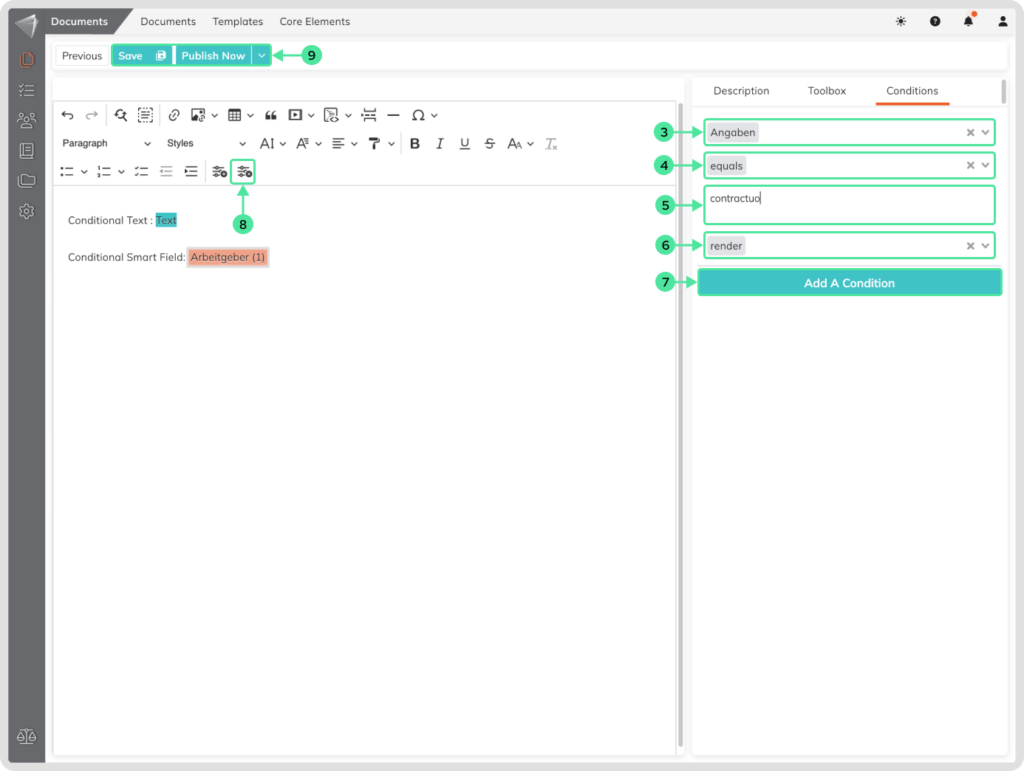
Advanced Table Features in Text Blocks
You can edit the text within your Text Block just like you would in a regular word processing environment. There are a few differences you should be aware of, especially when it comes to adding or deleting columns and rows within a table embedded in a Text Block. Here are the steps to do this:
- Click ‘Insert table’ within a Text Block to add a table and choose the desired table size (e.g., 1×1, 2×2, up to 10×10 cells).
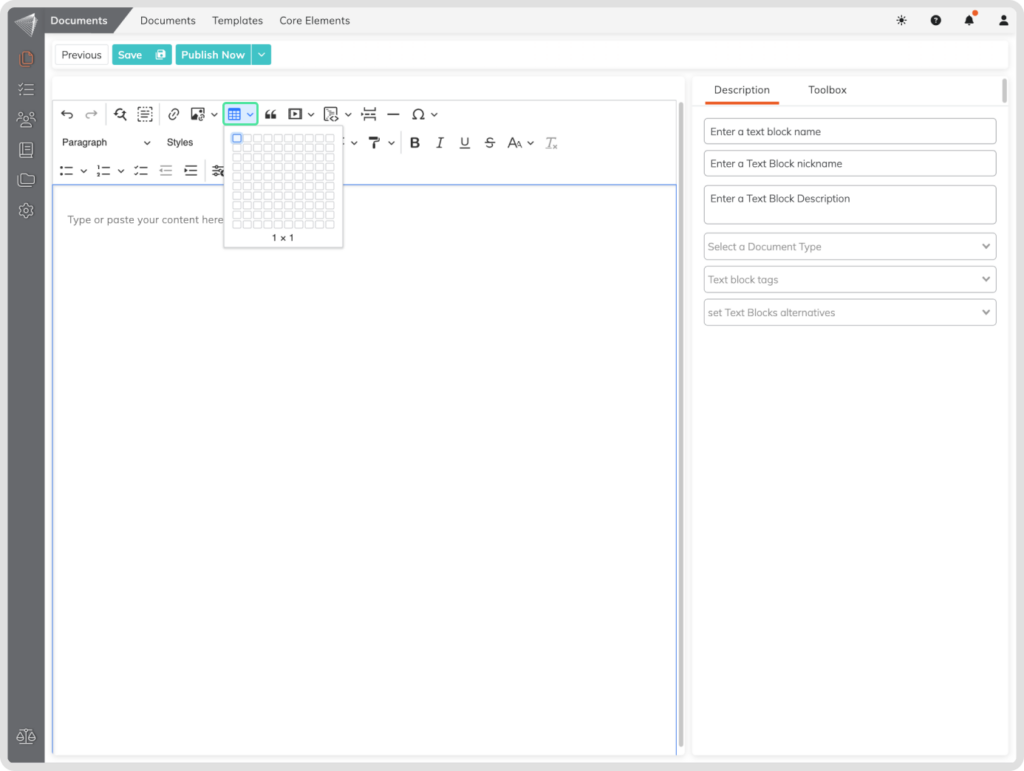
- Clicking inside a table cell lets you add/delete rows & columns, format the table, and merge cells.
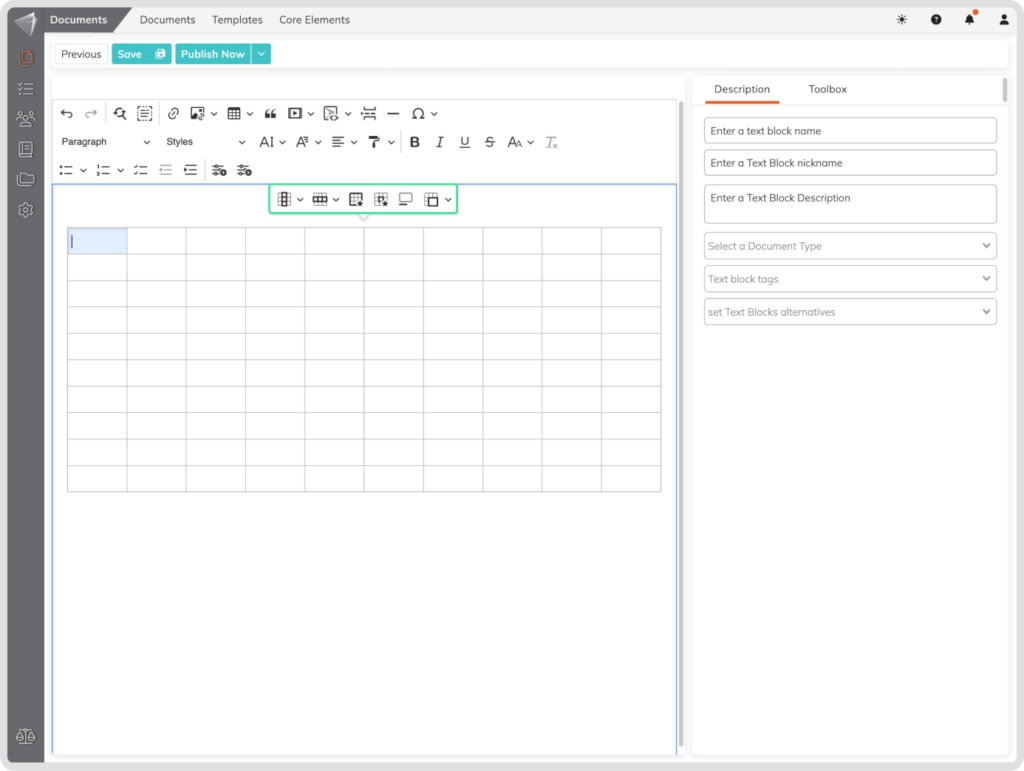
Inserting Text Blocks
There are three ways to insert text blocks into your documents:
- From Blank: When creating a new document from the “From Blank” button, access text blocks from the “Text Block” submenu in the sidebar menu.
- Document Templates: While creating or editing a document template, you can insert text blocks using the same “Text Block” submenu in the sidebar menu.
- Procedures: In step three of adding a blank document to a procedure, click the edit pen on the targeted document. You can then insert text blocks from the “Text Block” submenu in the sidebar menu.
In all three scenarios, the editor view is similar:
- Click on “Text Block” in the sidebar menu. You’ll see a list of all available text blocks.
- Click the “+” icon to insert a text block into the editor.
- Click the eye icon to preview the content of a text block without inserting it.
Once a text block is inserted:
- The cursor is restricted to the text block area.
- You can edit the content within the text block.
- Click the Enter icon above or below the text block border to exit the area.
- Clicking outside the text block and then pressing Delete will remove it.

Additional Informations
Sticky Paragraphs
What it is:
Sticky paragraphs is a function in the editor that allows you to keep a paragraph together that would otherwise be split across a page break. This can be useful for ensuring that related text stays together, such as a heading and its subheading, or the last line of a paragraph and the first line of a table.
How to use it:
- Click inside the Paragraph that you want to keep together.
- Click the Sticky paragraph button. A blue highlighted line will appear in front of the text to indicate that the function is active.
To undo:
- Click inside the Paragraph that has the sticky paragraph function applied.
- Click the Sticky paragraph button again. The blue highlighted line will disappear.
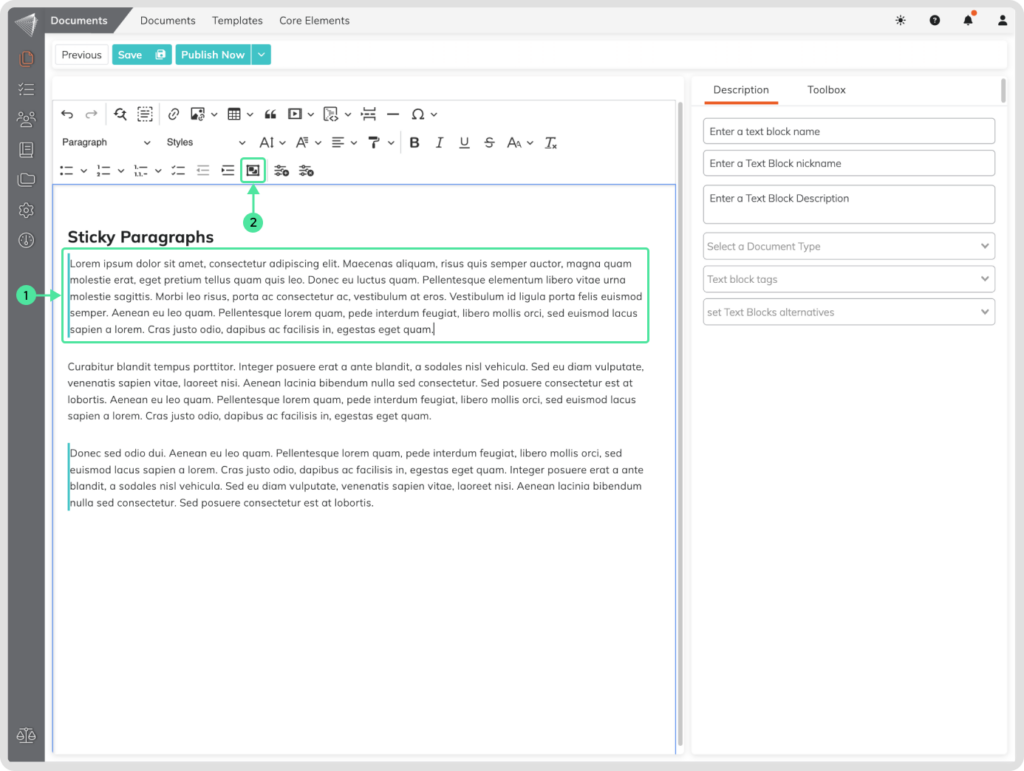
Example:
Let’s say you have a document with a heading and a subheading. The subheading is at the bottom of the page, and you want to keep it together with the heading on the next page. You can use the sticky paragraphs function to do this.
How to find the Text Block Timeline?
Click on an existing Text Block. On the right side, a sidebar will appear where the Timeline is included.
How to View the content of the Text Block inside the Timeline?
Inside the Text Block Timeline, click on the eye icon to view the content of a particular version.
Version control Timeline
Version control is essential for maintaining the integrity of Text Blocks over time, providing a historical record of changes, and the ability to revert to previous versions if needed.
By clicking on an existing Text Block, the sidebar menu will be displayed, where you can observe the Text Block timeline.
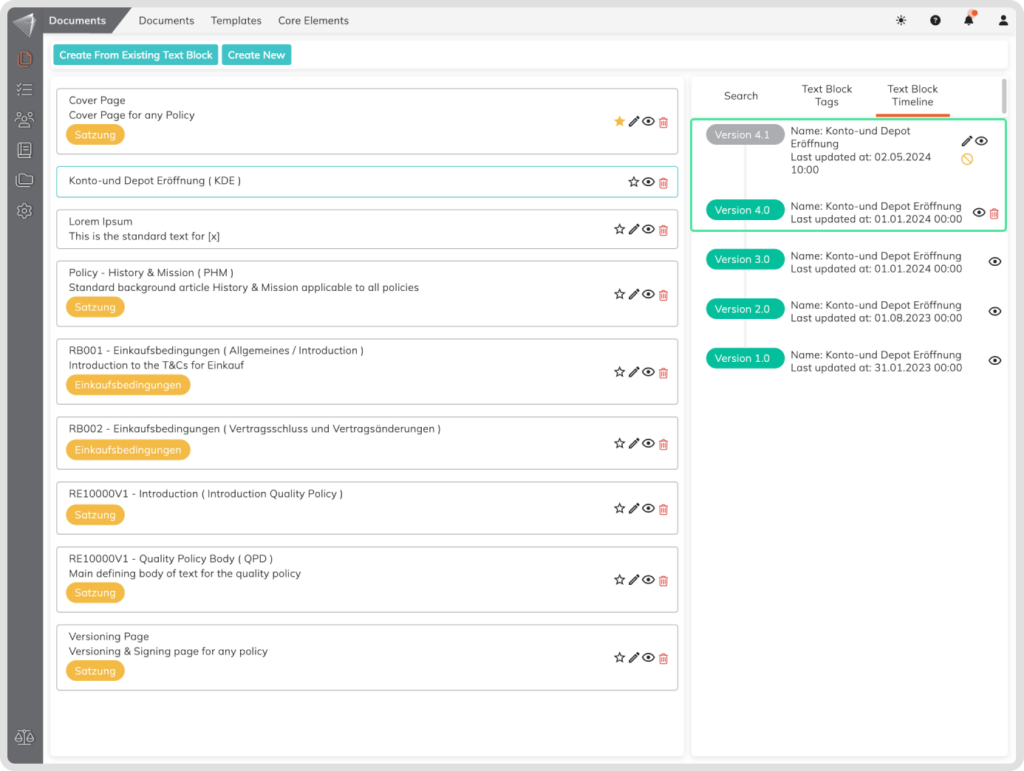
- Reverting to a Previous Version: Made some changes and want to go back? Simply click on the bin icon (trash can symbol) next to the Text Block. This will reverse your changes and bring back the previous version.
- Identifying Draft Versions: Draft versions of Text Blocks are displayed with a gray color to indicate they haven’t been published yet. These drafts are safe for editing without affecting the live version.
- Viewing Draft Content: Curious about what’s in a draft version? Click on the eye icon next to the draft to see its content without publishing it.
Editing Drafts from the Timeline: Working on a draft and need to make quick edits? Look for the edit pen icon on the timeline next to the draft Text Block. Clicking this pen allows you to edit the content directly within the timeline, which can be especially useful if the Text Block is long or located far down the page.
